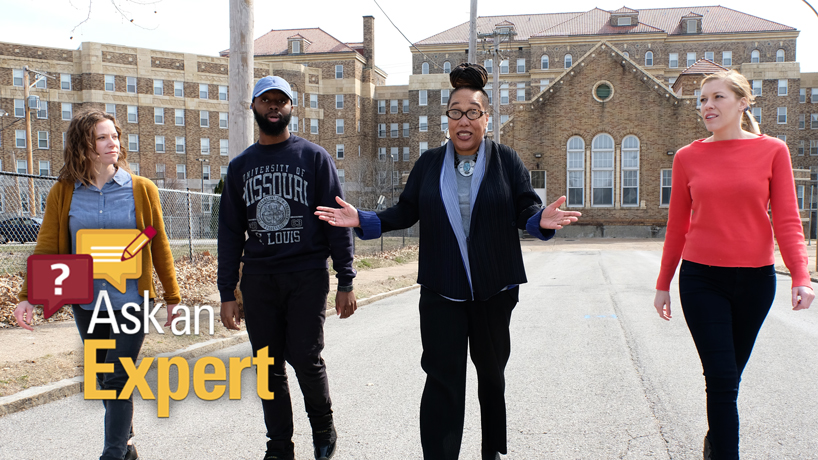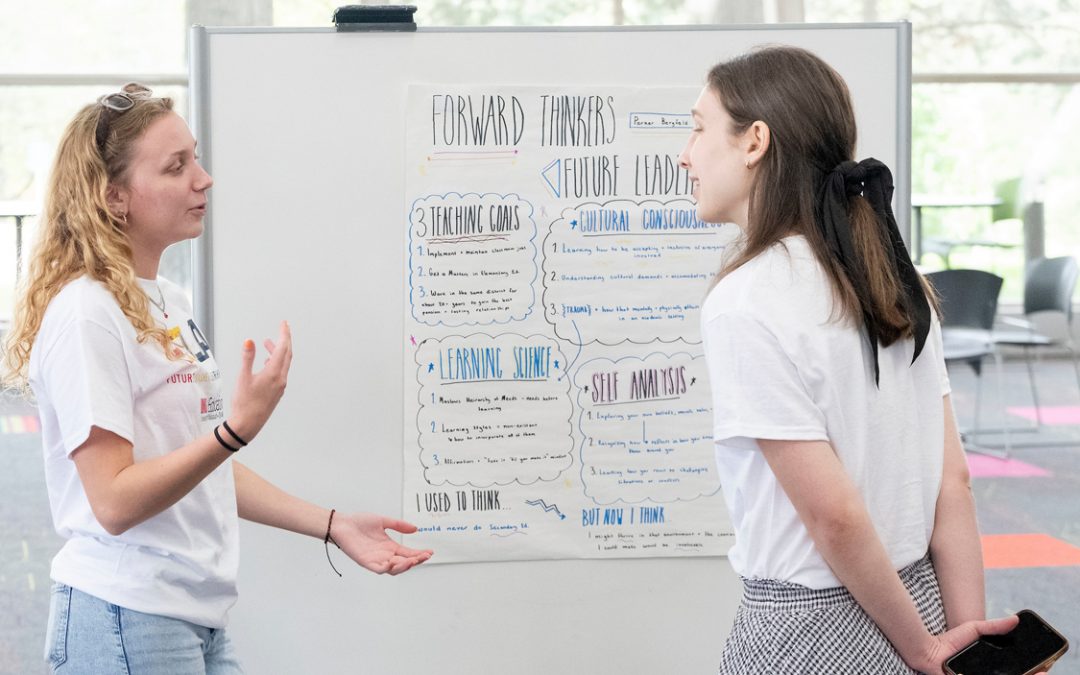
Historian Priscilla Dowden-White (second from right) is working on a biography of Margaret Bush Wilson, the first African American woman to chair the national board of the NAACP. (Photo by August Jennewein)
Margaret Bush Wilson was a pioneering figure in civil rights history in St. Louis with impact that reached far beyond.
Wilson, who was born in 1919 and died in 2009, was only the second African American woman to practice law in Missouri after graduating from Lincoln University Law School in 1943.
She became the first African American woman to run for Congress from Missouri in 1948 as a member of the Progressive Party, and that same year she was part of a team of lawyers working on the landmark Shelley v. Kraemer Supreme Court case that overturned race-restrictive covenants.
Wilson went on to serve as the president of the local and state chapters of the NAACP, helping win several civil rights cases during her tenure, and she became the first African American woman to chair the national NAACP board, serving nine terms.
Priscilla Dowden-White, an associate professor of history at the University of Missouri–St. Louis and author of “Groping toward Democracy: African American Social Welfare Reform in St. Louis, 1910-1949,” is currently at work on a biography of Wilson.
In the latest installment of the “Ask an Expert” series, UMSL Daily spoke to Dowden-White about Wilson and a few other notable civil rights figures from St. Louis who warrant more attention.
Where did your interest in Margaret Bush Wilson begin?
Mark Tranel, then the director of the Public Policy Research Center, was looking for someone to do a biography on Margaret Bush Wilson. He asked if anyone in the history department would be interested in exploring that, and I met with him to see what this was about. It turned out that Margaret Bush Wilson had left the university some money in her will, and she had not really specified exactly how it should be used beyond honoring her father, James T. Bush, a real estate broker who inspired the Shelley v. Kraemer case. Mark was attempting to figure out some kind of way to use that money to honor her and her father’s legacy, and at that time he was thinking about perhaps doing a symposium where attached to it would be a souvenir journal with a pamphlet-like biography of her.
Then he was interested in using the rest of the money to help foster the research for a book-length biography on her. I told him that I knew that I could commit to doing a pamphlet-type of project. I knew that there was enough material available for that but that I couldn’t commit to doing a book-length project until I found out if there were papers that existed that a historian could use for that purpose.
You’ve explained you were able to locate her papers collected at Washington University. What kinds of materials have you been able to see?
It’s over 800 boxes – over 800 linear feet of material – which is a wow moment. I remember telling one of my colleague friends at another university about this, and she said, “Margaret Bush Wilson thought highly of herself, didn’t she?” I laughed.
There are journals. She kept diaries. There’s personal correspondence in the collection of a very personal nature, and when you begin to go through the collection you realize that this was someone that was very intentional about saving these documents and that she wanted people to read this material after she passed.
What about her has captivated you?
If you were to go to an encyclopedia entry on her and see what her stated accomplishments were, they would fall into what I call pretty much a progressive civil rights narrative. You’ll see that one of her first activities as a young attorney, was to work – in a very minor way – on the Shelley v. Kraemer Supreme Court case that overturned race-restricted covenant agreements.
So, when you look at many of the accomplishments of Margaret Bush Wilson, you see this progressive civil rights narrative, but then when you look at some of the choices that she made, there seems to be a contradiction.
What are some of the reasons you say that?
I’ll give you an example. In 1991, she goes before the Senate Judiciary Committee and argues on behalf of Clarence Thomas’ Supreme Court nomination. Now, this may seem like a contradiction because Margaret Bush Wilson was an advocate for affirmative action in the NAACP, and she did not waiver on that. And she’s supporting someone who is not.
That’s just one example. She dies in 2009. The year before, Washington University gave an honorary doctorate degree to Phyllis Schlafly. Margaret Bush Wilson presented and I believe actually wrote the proclamation for Phyllis Schlafly to receive this honorary doctorate degree. Phyllis Schlafly and Margaret Bush Wilson were on opposite ends on a number of policies. For example, Margaret Bush Wilson was pro the Equal Rights Amendment, and she spoke before the Missouri House of Representatives in support of the ERA. She could not have disagreed more with many of Phyllis Schlafly’s views. Yet it was Margaret Bush Wilson who actually suggested Phyllis Schlafly for the degree.
How do you explain those contradictions?
I see Margaret Bush Wilson as a philosophical pragmatist, and she would often talk about this idea of an American aristocracy. She purported that Americans should strive to be aristocrats. She looked to Thomas Jefferson for this notion of a natural aristocracy built not on wealth or birth but on talent and virtue. Margaret Bush Wilson did not use the terms virtue and talent when she would describe her notion of an American aristocracy. She said the natural aristocracy that she recognized and that she promoted was one built on three pillars: character, competency and accomplishment.
Of course, pragmatism is also about understanding how we come to decisions. When you look at her support of Phyllis Schlafly for this honorary doctorate degree and if you go and find the footage of Margaret presenting the proclamation, she says today we are not here to honor someone based off of the policy decisions that they made. We’re here to honor a persona. Margaret looked at Schlafly’s accomplishments, and she said she’s someone who has gotten these degrees – she also has earned degrees from Wash U – and she’s accomplished all of this and that she should be honored for her accomplishments. We don’t all have to agree. But that’s that pragmatist thought there.
When we look at her support of Clarence Thomas, there’s something that if you didn’t already know would help you to understand how she came to that decision. When he graduated from Yale Law School in 1975, he came to St. Louis to study for the bar exam, and Senator John Danforth was looking for someone to house him over the summer. She said, “Oh, he can come and live with me. My son is away at school at Stanford, and I could use the company.” Clarence Thomas spent the summer with her, and that started their relationship, and so she began to view him as a son.
So, when he came up for this appointment, there was no way she was not going to support him. Some of her friends came to her and said, “Margaret, how could you do this?” And in one letter that I read to a friend who asked this question, she said, “Clarence and I have always disagreed and sometimes vehemently on policy decisions.” She said, “This is about friendship. It’s also that I have never questioned his integrity.” That’s where I saw that natural aristocracy piece coming in.
What do you think her greatest achievement or legacy is?
That’s a really challenging question for me to answer. Margaret lived 90 years from 1919 to 2009, and her life is really a window into what historians call the longer Civil Rights Movement. You could also add that her life as a civil rights leader was marked by a legal trail of landmark decisions and major advances that opened up doors to equality, not just for African Americans but for all Americans. When viewed together, her thought and praxis over the course of her life, we see a dynamic form of philosophical pragmatism, influenced by and reflected in her personal experience and fueled by a dogged believe in the American ideal of democracy and in the role that African Americans play in helping America to live up to that ideal.
I think beyond an act of historical recovery on a life of an African American woman whose life deserves historical study, I think it really has something instructive for us today as we look at our current political and civil discourse – to remind us of what is unique about America in a very good way.
Are there other people from the last 50 or 60 years – particularly from the St. Louis area – who you believe have played a significant role in modern civil rights who are underappreciated or that more should be known about?
I’ve thought about that, and one of them is the late Pearlie Evans. She died in 2016 at the age of 84. I think it’s safe to say that many St. Louisans of a certain age are familiar with Pearlie Evans if they have been paying attention to politics in St. Louis. But outside of that I don’t know that very many people would know her. She was also an activist and a social worker. I think it could be argued that she was the organizational force behind Congressman William Clay Sr. when he ran for Congress in 1968. Pearlie Evans helped open up Howard Johnson and White Castle, and she was also involved in the Jefferson Bank demonstrations of 1963. When the bank demonstrators were jailed, Pearlie Evans, Gwen Giles and Margaret Bush Wilson worked behind the scenes to publicize the plight of the demonstrators and to raise bail money.
Another person is Elizabeth Garlington, who was a social worker and activist and lifetime member of the NAACP. She was born in 1909 and died in 2006. She was about 10 years older than Margaret Bush Wilson. She was born in South Carolina, but she spent most of her life in St. Louis, and during World War II, she was reportedly the first African American professional to work for the Red Cross. She was one of the founding members of the National Association of Black Social Workers, and she became known in some circles as the mother of family therapy for developing a more holistic approach to social work. When you look at her activism, she was also involved in the Colored Clerks’ Circle in St. Louis during the late 1930s and early 40s. The Colored Clerks’ Circle was the local iteration of the national movement of the “Don’t Buy Where You Can’t Work” campaign. She was also involved in Marcus Garvey’s movement, the Universal Negro Improvement Association, in St. Louis.
A name that is more well-known but there needs to be a book on him – and he’s still alive, so someone really needs to get to him and begin interviewing him – that’s Percy Green II. There’s a good Wikipedia on him. Of course, he was involved in the Congress on Racial Equality and left CORE and became one of the founding members of the Action Committee to Improve Opportunities for Negroes, commonly known as ACTION. He was the plaintiff in the landmark Civil Rights case, McDonnell Douglas Corp. v. Green, and he and Richard Daly, a white man, scaled the Arch to protest the lack of black construction workers on the project when the Arch was underway. ACTION also during those years defrocked the Veiled Prophet at the Veiled Prophet Ball. I hope that someone will begin working with him to write a biography or a memoir on his life.














